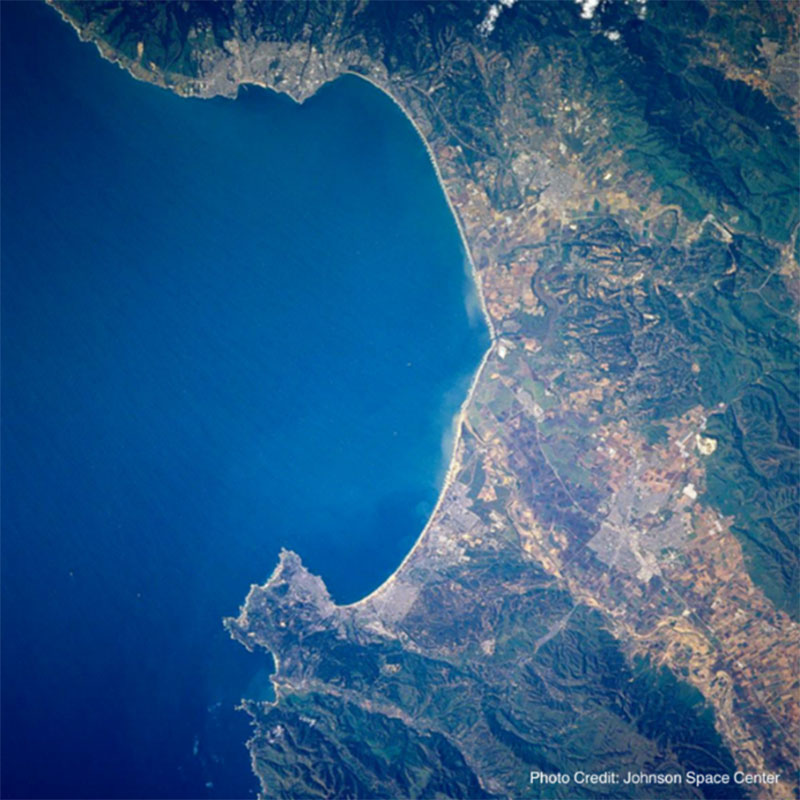The gorgeous Monterey Bay in Northern California is one of the most beautiful and cool places in the Golden State. And by cool, we’re talking both literally and figuratively. Us farmers know the huge “funnel” (depicted above) in the bay that sits at the beginning of the Salinas Valley creates the perfect channel to push frigid wind and fog from the Pacific Ocean directly over and into our valley. This seemingly ever-present marine layer and brisk sea breeze create a microclimate that keeps the ag fields from over-heating and contributes to the Salinas Valley upholding its moniker of being “The Salad Bowl of the World.”

This deep chasm in the Monterey Bay – known as a submarine canyon – is the largest such canyon along the entire west coast of the US and is over seven miles in width at its widest point. This massive canyon was formed by underwater erosion known as something called turbidity current erosion.

With depths exceeding two miles below sea level, this underwater canyon is as deep in the ocean as the base of the Grand Canyon is on land. The surface temperatures of the bay range from 49-55⁰F and get colder and darker the deeper you go.
As the Pacific Ocean current travels down the coast of California, it hits this deep bay trench and churns up the cold water at lower depths. This frigid water upwells to the ocean surface, meets the warm air and turns into fog. It’s this chilly fog bank, always present along the Monterey coastline in the summertime, that flows into the Salinas Valley and keeps our crops cool.
This also contributes to the temperate climate that exists all around the Monterey Bay area, creating the perfect environment to farm cool-climate crops, like artichokes and Brussels sprouts that thrive in foggy Mediterranean environments all summer long.

So we know the geology of Monterey Bay, complete with its deep cold water and rich layers of sediment in the submarine canyon, offer a mild year-round climate and plentiful fertile soil. What many may not realize is this is one of the few true Mediterranean climates in the country, with the majority of them being in California.
This soil, some of the most fertile in the world, was created over thousands of years when surrounding mountains deposited rich sediment to create deep topsoil which makes this area prime farmland.

Another geological factor that the Monterey Bay region is blessed with is its underground water supply, which is fed from watershed in the mountains around the valley. There are also two reservoirs – Antonio and Nacimiento – which contribute to creating a perfect environment to grow abundant crops in this area known as “the salad bowl” in the Salinas Valley.
As an almost century-old company, comprised of family farmers who came to American from Italy in 1924 bringing with them their beloved artichokes, we know how important it is to be true stewards of this amazing farmland that we are able to grow and harvest beautiful fresh crops in. And as the largest grower/shipper of artichokes in North America, we have no plans of slowing down.



Love to make your artichokes stuffed with garlic and my flavored bread crumbs.
I always enjoy your newsletters and this is no exception! Very interesting information about the geology that contributes to the success of the crops. Monterey is unique an oh so beautiful.
Great Article! Geology, the Monterey Bay and Farming August 14, 2023 by Ocean Mist Farms.
Interesting but I was hoping I had won a case of your fabulous Artichokes!!!
Very interesting article on the topography of the area and why the crops thrive there.
Very interesting, thank you
Great article, Thank you
Great article. Learned something new. So glad our Italian immigrants brought the artichoke with them. Hope this tradition continues for many many more years.
Oceanmist farms are hard to beat. Great job to everyone
Interesting facts on your area. Thanks for sharing
Very interesting srory about the geology. Thanks!
I live in British Columbia, Canada. I lived in San Miguel, 90 miles south of Salinas . I was also stationed at Fort Ord in 1970-1971, know the area well, I agree, the food crops from that region are exceptional!
I miss perennial (heirloom) artichokes! The annual kind just do not have that great artichoke flavor. In recent years it’s been getting harder and harder to find the perennial kind in stores, and this spring I never found any. I hope Ocean Mist isn’t reducing how many they grow, in favor of the annual variety.
Wonderful story,thanks for sharing…